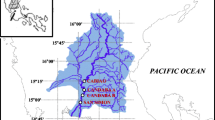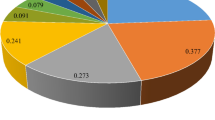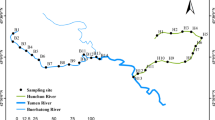Abstract
Organochlorine pesticides, the potential chemical pollutants, are extensively used for agriculture and vector control purposes due to their low cost and high effectiveness. DDT and HCH residues were examined in different surface and groundwater resources of district Dibrugarh and Nagaon of Assam state, Northeast India. The mean HCH concentrations in surface water samples were 4403 ng/L and 4911 ng/L, while 5168 ng/L and 5574 ng/L in groundwater samples from Dibrugarh and Nagaon districts respectively. Total DDT levels were 5402 ng/L and 6121 ng/L in surface water while 6549 ng/L and 6904 ng/L in groundwater from Dibrugarh and Nagaon respectively. DDT levels in groundwater were found to be highest among the levels reported so far. The dominant OCPs were found to be β-HCH among HCHs and p,p′-DDT among DDTs. The ratios of DDT/(DDE+DDD) and α-HCH/γ-HCH revealed that residue levels in water were originated from long past to recent mixed source of technical HCH and lindane for HCHs and mainly technical DDT for DDTs. About 93% samples for DDT and 90% samples for HCH exceeded the WHO recommended drinking water limits which is a matter of great concern and posing a serious threat to aquatic ecosystem and human health. Spatial distribution was also investigated to identify the areas with higher pesticide loadings in groundwater. Present data on contamination profile of OCPs in this survey can be used as reference levels for future POPs monitoring programme.
Similar content being viewed by others

References
Sankararamakrishnan, N., Sharma, A. K. & Sanghi, R. Organochlorine and organophosphorus pesticide residues in groundwater and surface waters of Kanpur, Uttar Pradesh, India. Environ. Int. 31, 113–120 (2005).
Bhattacharya, B., Sarkar, S. K. & Mukherjee, N. Organochlorine pesticide residues in sediments of a tropical mangrove estuary, India: implications for monitoring. Environ. Int. 29, 587–592 (2003).
Ramesh, A., Tanabe, S., Iwata, H. & Tatsukawa, R. Seasonal variation of persistent organochlorine insecticide residues in Vellar River Waters in Tamil Nadu, South India. Environ. Pollut. 67, 289–304 (1990).
Abhilash, P. C. & Singh, N. Pesticide use and application: An Indian Scenario. J. Hazard. Mater. 165, 1–12 (2009).
Gupta, P. K. Pesticide exposure-Indian scene. Toxicol. 198, 83–90 (2004).
Jayshree, R. & Vasudevan, N. Organochlorine pesticide residues in groundwater of Thiruvallur district, India. Environ. Monit. Assess. 128, 209–215 (2007).
Li, X., Shen, Z., Wai, O. W. H. & Li, Y. Chemical partitioning of heavy metal contaminants in sediment of the Pearl River estuary. Chem. Spec. Bioavail. 12, 17–25 (2000).
Agnihotri, N. P. Pesticide Safety and Monitoring. All India Coordinated Research Project on Pesticides Residues, Indian Council of Agricultural Research, New Delhi, India (1999).
UNEP. Global report on regionally based assessment of persistent toxic substances, UNEP Chemicals. Geneva, Switzerland (2003).
Dutta Gupta, S., Gupta, S. & Gupta, A. Euglenoid blooms in the flood plain wetlands of Barak Valley, Assam, North-Eastern India. J. Environ. Biol. 25, 369–373 (2003).
Prakash, O. et al. Residues of Hexachlorocyclohexane isomers in soil and water samples from Delhi and adjoining areas. Cur. Sci. 87, 73–77 (2004).
Dev, V., Hira, C. R. & Rajkhoma, M. K. Malaria-attributable morbidity in Assam, north eastern India. Ann. Trop. Med. Parasitol. 95, 789–796 (2001).
APHA. Standard Methods for the Examination of Water and Wastewater, American Public Health Association, 18th Edition, Washington, DC (1992).
Zhou, R., Zhu, L., Yang, K. & Chen, Y. Distrbution of organochlorine pesticides in surface water and sediments from Qiantang River, East China. J. Hazard. Mater. A. 137, 68–75 (2006).
Zhang, Z., Huang, J., Yu, G. & Hong, H. Occurrence of PAHs, PCBs and organochlorine pesticides in the Tonghui River of Beijing, China. Environ. Pollut. 130, 249–261 (2004).
Chen, J., Liu, C., Yang, Z. & Wang, J. Residues and characteristics of organochlorine pesticides in the surface water in the suburb of Beijing. Earth. Sci. Front. 15, 242–247 (2008).
Golfinopoulos, S. K. et al. Organochlorine pesticides in the surface waters of Northern Greece. Chemosphere 50, 507–516 (2003).
Rissato, S. R. et al. Organochlorine pesticides and polychlorinated biphenyls in soil and water samples in the northeastern part of Sao Paulo State, Brazil. Chemosphere 65, 1949–1958 (2006).
Rajendran, R. B. & Subramanian, A. N. Pesticide residues in water from the river Kaveri, south India. Chem. Ecol. 13, 223–236 (1997).
Ghose, N. C., Saha, D. & Gupta, A. Synthetic detergents (surfactants) and organochlorine pesticide signatures in surface water and groundwater of greater Kolkata, India. J. Wat. Res. Protect. 4, 290–298 (2009).
Ayas, Z., Barlas, N. & Kolankaya, D. Determination of organochlorine pesticide residues in various environments and organisms in Goksu Delta, Turkey. Aqua. Toxicol. 39, 171–181 (1997).
Begum, A., Harikrishna, S. & Khan, I. A survey of persistent organochlorine pesticides residues in some streams of the Cauvery River, Karnataka, India. Int. J. Chem. Tech. Res. 1, 237–244 (2009).
Darko, G., Akoto, O. & Oppong, C. Persistent organochlorine pesticide residues in fish, sediments and water from lake Bosomtwi, Ghana. Chemosphere 72, 21–24 (2008).
Caldas, E. D., Coelho, L., Souza, C. K. R. & Siba, S. C. Organochlorine pesticides in water, sediment, and fish of Paranoa lake of Brasilia, Brazil. Bull. Environ. Contam. Toxicol. 62, 199–206 (1999).
Matin, M. A. et al. Organochlorine insecticide residues in surface and underground water from different regions of Bangladesh. Agri. Ecos. Environ. 69, 11–15 (1998).
Rao, A. S. & Pillai, R. R. Kolleru Lake water pollution pesticides. Indian. J. Environ. Health. 42, 169–175 (2000).
Sarma, S. K. & Saikia, M. Utilization of wetland resources by the rural people of Nagaon district, Assam. Indian. J. Trad. Know. 9, 145–151 (2010).
Miller, G. T. Sustaining the Earth, 6th Edition. Thompson Learning, Inc. Pacific Grove, California, 211–216 (2004).
Belfroid, A. C., Van, D. M., Beck, M. A., Vangestal, C. A. M. & Van, H. B. Relative risks of transformation products of pesticides for aquatic ecosystems. Sci. Tot. Environ. 222, 167–183 (1998).
Mohapatra, S. P., Kumar, M., Gajbhiye, V. T. & Agnihotri, N. P. Groundwater contamination by organochlorine insecticide residues in a rural area in the Indo-Gangetic Plain. Environ. Monit. Assess. 35, 155–164 (1995).
Singh, R. P. Comparison of organochlorine pesticide levels in soil and groundwater of Agra, India. Bull. Environ. Contam. Toxicol. 67, 126–132 (2001).
Singh, K. P., Malik, A., Mohan, D. & Sinha, S. Persistant organochlorine pesticide residue in alluvial groundwater aquifers of Ganga Plain, India. Bull. Environ. Contam. Toxicol. 74, 162–169 (2005).
Sharma, A. & Khan, T. I. Organochlorine pesticides in irrigation water of Jaipur city (India). J. Environ. Sci. Engg. 51, 175–178 (2009).
WHO. Drinking water standards, World Health Organisation, Geneva (1993).
Voldner, E. C. & Li, Y. F. Global usage of persistent organochlorines. Sci. Total. Environ. (160/161), 201–210 (1995).
NIC. Dibrugarh district profile. http://dibrugarh.gov.in/ glance.html (2004–05).
NIC. Nagaon-at a glance. http://nagaon.nic.in/glance. html (2004–05).
Henk, V. D. B. Global status of DDT and its alternatives for use in vector control to prevent disease. Stockholm Convention/United Nations Environment Programme. (2008). http://www.pops.int/documents/ddt/ Global%20status%20of%20DDT%20SSC%2020Oct 08.pdf. Retrieved 2008-11-22.
Agnihotri, N. P., Kulshreshtha, G., Gajbhiye, V. T., Mohapatra, S. P. & Singh, S. B. Organochlorine insecticide residues in agricultural soils of the Indo-Gangetic plain. Environ. Monit. Assess. 40, 279–288 (1996).
Imphal Free Press. Concern over excessive DDT use in Jiribam fields. (2008). http://www.kanglaonline.com /index.php?template=headline&newsid=42015&typei d=1. Retrieved 2008-05-05.
Sarkar, S. K. et al. Occurrence, distribution and possible sources of organochlorine pesticide residues in tropical coastal environment of India: an overview. Environ. Int. 34, 1062–1071 (2008).
UNEP. Persistent organic pollutants. Workshop Proceedings. United Nations. Environment Programme. (2008). http://www.chem.unep.ch/Pops/POPs_Inc /proceedings/coverpgs/procovers.htm.
CGWB. Groundwater information system. (2010). http://gis2.nic.in/cgwb/Gemsdata.aspx
Harner, T., Wideman, J. L., Jantunen, L. M. M., Bidleman, T. F. & Parkhurst, W. J. Residues of organochlorine pesticides in Alabama soils. Environ. Pollut. 106, 323–332 (1999).
WHO. DDT and its derivatives. Environmental Health Criteria 9. World Health Organization, Geneva, Switzerland. 1–194 (1979).
Yuan, D., Yang, D., Wade, T. L. & Qian, Y. Status of persistent organic pollutants in the sediments from several estuaries in China. Environ. Pollut. 114, 101–111 (2001).
Jaga, K. & Dharmani, C. Global Surveillance of DDT and DDE levels in Human tissues. Int. J. Occup. Environ. Health 16, 7–20 (2003).
Loganathan, B. G., Kannan, K. Global organochlorine contamination trends: an overview. Ambio 23, 187–191 (1994).
BIS. Specifications for Drinking Water. IS: 10500: 1991, Bureau of Indian Standards, New Delhi (1991).
Author information
Authors and Affiliations
Corresponding author
Rights and permissions
About this article
Cite this article
Mishra, K., Sharma, R.C. Contamination of aquatic system by chlorinated pesticides and their spatial distribution over North-East India. Toxicol. Environ. Health Sci. 3, 144–155 (2011). https://doi.org/10.1007/s13530-011-0092-3
Received:
Revised:
Accepted:
Published:
Issue Date:
DOI: https://doi.org/10.1007/s13530-011-0092-3



